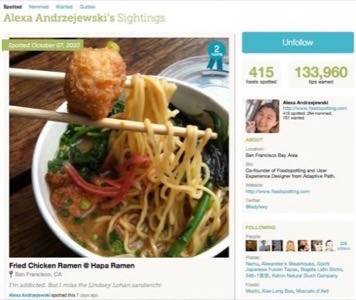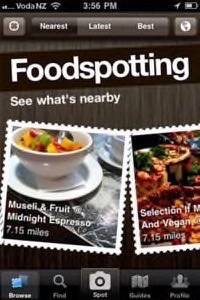This year check-in apps have moved beyond location, to encompass every thing from checking into movies, books, songs and (yes) even food. Foodspotting launched last November and has quickly built up a passionate following of foodies. It enables users to make and find food recommendations, in particular through photos and quick ratings of food items.

It may sound like an odd thing to do, to stop and take a photo of a plate of food. But it turns out that Foodspotting is a handy way to discover what foods are recommended in a particular city or area. It might come in useful when on holiday, for example. I spoke to Foodspotting co-founder and CEO Alexa Andrzejewski to find out what inspired the product, who’s using it, and the company’s surprising plans to expand beyond food.

Richard MacManus: How did you come up with the idea for Foodspotting?
Alexa Andrzejewski: The original idea was inspired by my traveling to Japan and Korea, where I learned about all of these different foods that I’d never heard about growing up. So my original idea was to create a way for people to learn about new foods around the world and then find those foods locally. My initial idea was actually to create a book that would help people do that. But then, when I shared the idea with people I realized that it would be so much more useful as a mobile app.
“People are really into the photo aspect, [so] I could make Foodspotting uniquely mobile.”
I was working for company called Adaptive Path at that time, which does use experience consulting, strategy and imagining. I worked in a lot of projects there thinking about the future of mobile and I’ve worked for some of the major handset manufacturers, thinking about the future of mobile and what it will be like five years from now. [for example] We had the idea of the mobile device being less like a phone and more like a lens on the world, that shows you more information about things around you. And I realized that people are really into the photo aspect, [so] I could make Foodspotting uniquely mobile.
RM: What time period was it when you first came up with the idea and started to play around with this concept?
AA: I first came up with the idea in January 2009, then it was about 6 months from the original idea of it being a book to knowing that I wanted to do this as an app. In August of 2009 I started looking in earnest for a co-founder who could do the technological part.
RM: When did the development of the product start?
AA: September 2009. And we launched a private beta in November 2009.We launched publicly on January with the website and we launched the iPhone App at SXSW in March of 2010.
RM: Right. So since the launch of the product, has the vision for the product changed at all – or was it pretty much what you envisioned back in August-September 2009?
Foodspotting “has evolved into being a discovery engine for the real world.”
AA: I think definitely it has evolved. Initially it was really focused on it being our way to find specific dishes and focused on learning about new foods and that kind of thing.
But the vision for it has evolved into being a discovery engine for the real world. A way to stumble upon good things around you, wherever you go.
We’ve been thinking about how Foodspotting can be useful to anybody, not just serious foodies. Originally it was about finding specific dishes that were kind of obscure. But that was a relatively small audience. And the more we brainstormed, [the more] we wanted this to be for anybody who’s looking for good food. So we thought, why can’t we create something that is compelling and useful to the mass market not just to like serious foodies. It can be eventually extended beyond food too.
RM: I see, so do you have plans to expand beyond food?
AA: Yes, that’s something we have kept in mind – but we’d like to do food well first, because it’s the natural fit. At the same time there’s been an interest in people sharing other interesting fine products or travel experiences, like sites to see and things like that. In the same way, this idea of being a visual discovery engine could easily extend to other things as well. So that’s something we’re interested in exploring.
Usage Patterns
RM: What have been the main usage patterns that you’ve noticed?
“The weekends is when people spotting food happens the most.”
AA: The weekends is when people spotting food happens the most, there’s a very clear spike then. And the audience of people who love food [is] very active. People who post food, the foodspotters, there’s 65,000 of them. We have 300,000 app users in total.
Some people have 2,000 things that they’ve posted and some have a couple of hundred. We were surprised by how much content a single person can generate.
We get between 8 and 10 thousand [app] launches a day. And we get up to a thousand [food] sightings per day.

RM: That’s great! Is there a particular type of user, are there any patterns there?
AA: Well at the moment, we’ve definitely skewed towards 20-30 year old female Asians. If you look around San Francisco, you’ll see Asian Americans taking pictures of food. There’s definitely something there – it’s more of a culture that shares, celebrates dishes and food.
The Future of Foodspotting
RM: Do you have any plans to integrate Foodspotting with barcodes or RFID tags on food packaging?
AA: Not right now, no. We do a little bit of people spotting packaged food at stores, but most of it is food on a plate. And I think the idea of having people add barcodes to things is just not realistic. The idea of getting [info from] barcodes that are already there would definitely be very interesting.
RM: What other interesting features are you cooking up?
“In the long run, Foodspotting is going to become a lot smarter.”
AA: We’re working on game mechanics around people’s regions, because we’ve realized that a lot of people share foods and take a lot of pride in their regions. Showing off food from their hometowns and from their home countries. So we’re exploring some interesting game mechanics around that.
We’ve developed a platform for creating location-based guides, which are kind of like playlists for stuff in the real world that you want to try – or that somebody has recommended. That’s another interesting aspect of the food-finding platform that we’re working on refining.
In the long run, Foodspotting is going to become a lot smarter. So when you launch the app, instead of just seeing the nearest, latest or best foods – you will see things that are recommended for you based on your social graph and on the kinds of food you’ve viewed in the past. We [also] want it to become a lot easier to find things that are likely to be good to you – and use all kinds of data to do that.









